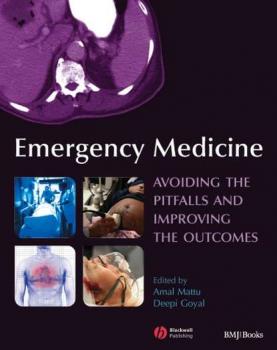ТОП просматриваемых книг сайта:
Amal Mattu
Список книг автора Amal MattuАннотация
Emergency Medicine is a brand new book focusing on the common pitfalls and mistakes that can occur when dealing with high-risk conditions during standard medical practice. Concise chapters focus on clinical relevance, addressing the mistakes, the consequences and the knowledge necessary to avoid high-risk mistakes. An essential book for all staff dealing with emergencies.
Аннотация
Inherent to the teaching and practice of emergency medicine are specific challenges not found in other specialties – the unknowns of the emergency department, the need to identify life- and limb-threatening conditions, the pressure to solve problems and find solutions quickly, and the orchestration of clinical specialists and ancillary services. Because of these unique demands, books written by clinicians from other disciplines, that extrapolate their information from other specialties, aren’t always suitable references for teachers of emergency medicine. This book is different – it shows how to incorporate effective teaching strategies into the unique teaching atmosphere of the emergency department, how to effectively lecture, lead small groups, give feedback, foster life-long faculty development skills, and much more – it is written by emergency medicine physicians for emergency medicine physicians. Practical Teaching in Emergency Medicine gets to the essential core of how to best teach the art of practicing emergency medicine – and provides the blueprint to become a better teacher, providing guidance on how to accomplish skilful teaching in busy emergency departments. It provides emergency physicians and trainees with the necessary tools to effectively and efficiently transmit information to learners in the often times chaotic emergency department environment.
Аннотация
The elderly represent the fastest growing segment of the population in developed countries, reflected in the patient population presenting to EDs and hospitals. These patients more often than not have greater co-morbidities, more complicated workups and utilize more laboratory and radiologic services. This text is designed to teach emergency physicians how best to care for this specific demographic of patients. It addresses physiologic changes, high-risk conditions, and atypical presentations associated with elderly patients in the ED that result in frequent misdiagnosis or delays in diagnosis. It instructs the readers how best to care for elderly patients in order to minimize morbidity and mortality, addressing some of the difficult psychosocial issues that confront health care providers that care for elderly patients, such as psychiatric disease and end-of-life care. The utility of this text is not limited to emergency physicians, but it should be useful to all health care providers involved in the treatment of elderly patients with acute medical or surgical conditions.
Аннотация
With over 200 traces to test your knowledge, this book is a first class learning tool for emergency physicians. Basic student-level knowledge of ECGs is assumed, so the reader can move directly to learning about the more complex traces that occur in the emergency department. The level of difficulty is stratified into two sections for specialists in training and specialist emergency physicians. A minimum amount of information is given beneath each trace, as if in the real situation. The full clinical description is printed in a separate section to avoid the temptation of “looking”. Accompanied by learning points, and with the cases presented randomly, this book provides a rich source of information on the interpretation of ECGs – a core skill for all emergency department staff.




